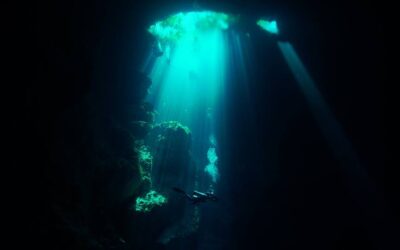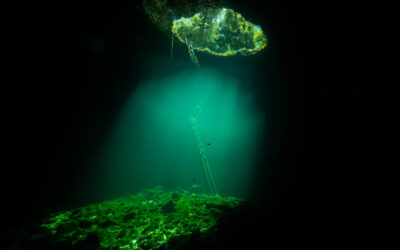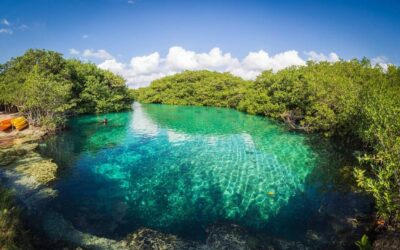What is a Halocline?
Where Fresh Water and Salt Water Meet is called a Halocline. A Halocline is defined as, the level where the amount of dissolved salt changes sufficiently to be able to see. We see this phenomenon in the caves of the Yucatan while scuba diving.
What does Halocline mean?
The word comes from Greek. Halo means salt, and Cline means slope or graduation. It is where the higher fresh water, that has fallen as rain, meets the lower salt water, that comes in from the sea.
What’s the difference between a Thermocline and a Halocline?
A thermocline is a change in temperature, whereas a Halocline is a change in salinity, in the level of water. There is a change in temperature in a halocline. In the cenotes, in Mexico, the temperature rises a degree or two as we descend into the salt water layer.
At the end of a long cave dive, if we spend time in the nice warm salty water, it can feel quite cold going back up into the colder fresh water.
What is the Mixing Zone?
When Salt and Fresh Water mix it is called a mixing zone. Sometimes in a cave system, we see two Haloclines at different levels. So there is a higher fresh water level. Then brackish water in the Mixing Zone. Then salt water in the lower level.
What does a place where Fresh Water meets Salt Water look like?
Salt makes the water denser so light bends as it passes from one to the other. When it’s undisturbed we can see waves rising and falling caused by the slightly faster flowing fresh water. It looks like another surface to the water. It’s best to shine your light across the layer to see it better. The refraction works better.
When we dive through it the salt water and fresh water mix together and it all gets very blurry. This is different from a mixing zone because it hasn’t fully mixed yet. Light is massively distorted and the effect is like a mirage in the desert which can be a little challenging sometimes in a cave.
To get the best visual effect we position ourselves with our eyes just on the Halocline. The salt water is warmer so we have a warm body but a cold head. It looks crazy, stunning. Words cannot fully describe the beauty. As we rise and fall gently with each breath, we slowly propel ourselves through the layer keeping it fresh and clean. We see concentrated horizontal beams of light and the rocks behind distort as if in a hall of mirrors at a fairground.
Are Cenotes Fresh or Salt Water?
It depends on how deep and how close to the sea they are. A shallower cenote further inland is likely to be fresh water, but the deeper you go down into the cave the higher the chance of encountering the salt water. Having said that, the closer to the sea you get the bigger the mixing zone so there is more chance of brackish water.
Where can I see a Halocline?
The Pit Cenote Mexico 2021 El Pit Tulum
Have you seen the Dancing Light at The Pit Cenote Mexico?
Cenote Calavera Tulum is the Temple of Doom Mexico 2021
Have you seen the Halocline Scuba Diving Cenote Calavera, Tulum?
Casa Cenote Diving 2021 Discovering the Mangroves from below
Explore beneath the Mangroves at Casa Cenote. Discover the Beauty Diving below.


